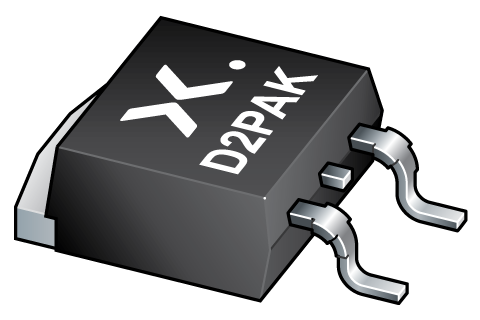
Register once, drag and drop ECAD models into your CAD tool and speed up your design.
Click here for more informationPSMN009-100B
N-channel TrenchMOS SiliconMAX standard level FET
SiliconMAX standard level N-channel enhancement mode Field-Effect Transistor (FET) in a plastic package using TrenchMOS technology. This product is designed and qualified for use in computing, communications, consumer and industrial applications only.
Features and benefits
Low conduction losses due to low on-state resistance
Suitable for high frequency applications due to fast switching characteristics
Applications
High frequency computer motherboard DC-to-DC convertors
OR-ing applicationss
Parametrics
| Type number | Package version | Package name | Product status | Channel type | Nr of transistors | VDS [max] (V) | RDSon [max] @ VGS = 10 V (mΩ) | Tj [max] (°C) | ID [max] (A) | QGD [typ] (nC) | QG(tot) [typ] @ VGS = 10 V (nC) | Ptot [max] (W) | VGSth [typ] (V) | Automotive qualified | Ciss [typ] (pF) | Coss [typ] (pF) | Release date |
|---|---|---|---|---|---|---|---|---|---|---|---|---|---|---|---|---|---|
| PSMN009-100B | SOT404 | D2PAK | End of life | N | 1 | 100 | 8.8 | 175 | 75 | 44 | 156 | 230 | 3 | N | 8250 | 620 | 2010-10-27 |
Package
All type numbers in the table below are discontinued.
| Type number | Orderable part number, (Ordering code (12NC)) | Status | Marking | Package | Package information | Reflow-/Wave soldering | Packing |
|---|---|---|---|---|---|---|---|
| PSMN009-100B | PSMN009-100B,118 (934057045118) |
Discontinued / End-of-life | PSMN009 100B |

D2PAK (SOT404) |
SOT404 |
REFLOW_BG-BD-1
WAVE_BG-BD-1 |
SOT404_118 |
Environmental information
All type numbers in the table below are discontinued.
| Type number | Orderable part number | Chemical content | RoHS | RHF-indicator |
|---|---|---|---|---|
| PSMN009-100B | PSMN009-100B,118 | PSMN009-100B |
|
|
Documentation (21)
| File name | Title | Type | Date |
|---|---|---|---|
| PSMN009-100B | N-channel TrenchMOS SiliconMAX standard level FET | Data sheet | 2017-05-08 |
| AN10273 | Power MOSFET single-shot and repetitive avalanche ruggedness rating | Application note | 2022-06-20 |
| AN10874_ZH | LFPAK MOSFET thermal design guide, Chinese version | Application note | 2020-04-30 |
| AN11113_ZH | LFPAK MOSFET thermal design guide - Part 2 | Application note | 2020-04-30 |
| AN11156 | Using Power MOSFET Zth Curves | Application note | 2021-01-04 |
| AN11158 | Understanding power MOSFET data sheet parameters | Application note | 2025-02-18 |
| AN11158_ZH | Understanding power MOSFET data sheet parameters | Application note | 2021-01-04 |
| AN11160 | Designing RC Snubbers | Application note | 2024-10-21 |
| AN11243 | Failure signature of Electrical Overstress on Power MOSFETs | Application note | 2025-03-20 |
| AN11261 | RC Thermal Models | Application note | 2021-03-18 |
| AN11599 | Using power MOSFETs in parallel | Application note | 2016-07-13 |
| AN90063 | Questions about package outline drawings | Application note | 2025-03-12 |
| SOT404 | 3D model for products with SOT226 package | Design support | 2017-06-30 |
| Nexperia_package_poster | Nexperia package poster | Leaflet | 2020-05-15 |
| D2PAK_SOT404_mk | plastic, single-ended surface-mounted package (D2PAK); 3 terminals (one lead cropped); 2.54 mm pitch; 11 mm x 10 mm x 4.3 mm body | Marcom graphics | 2017-01-28 |
| SOT404 | plastic, single-ended surface-mounted package (D2PAK); 3 terminals (one lead cropped); 2.54 mm pitch; 11 mm x 10 mm x 4.3 mm body | Package information | 2022-05-27 |
| Reliability_information_t3_sot404 | Reliability Information T3-SOT404 | Quality document | 2023-01-27 |
| T3_SOT404_PSMN009-100B_Nexperia_Quality_document | PSMN009-100B Quality document | Quality document | 2023-01-27 |
| REFLOW_BG-BD-1 | Reflow soldering profile | Reflow soldering | 2021-04-06 |
| TN00008 | Power MOSFET frequently asked questions and answers | Technical note | 2024-08-09 |
| WAVE_BG-BD-1 | Wave soldering profile | Wave soldering | 2021-09-08 |
Support
If you are in need of design/technical support, let us know and fill in the answer form we'll get back to you shortly.
Longevity
The Nexperia Longevity Program is aimed to provide our customers information from time to time about the expected time that our products can be ordered. The NLP is reviewed and updated regularly by our Executive Management Team. View our longevity program here.
Models
| File name | Title | Type | Date |
|---|---|---|---|
| SOT404 | 3D model for products with SOT226 package | Design support | 2017-06-30 |
How does it work?
The interactive datasheets are based on the Nexperia MOSFET precision electrothermal models. With our interactive datasheets you can simply specify your own conditions interactively. Start by changing the values of the conditions. You can do this by using the sliders in the condition fields. By dragging the sliders you will see how the MOSFET will perform at the new conditions set.